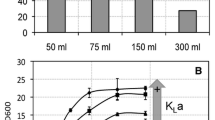Abstract
WhenClostridium acetobutylicum was grown in batch culture under iron limitation (0.2 mg·l−1) at a pH of 4.8, glucose was fermented, to butanol as the major fermentation end product, and small quantities of acetic acid were produced. The final conversion yield of glucose into butanol could be increased from 20% to 30% by iron limitation. The acetonebutanol ratio was changed from 3.7 (control) to 11.8. Hydrogenase specific activity was decreased by 40% and acetoacetate decarboxylase specific activity by 25% under iron limitation. Thus, iron limitation affects carbon and electron flow in addition to hydrogenase.
Similar content being viewed by others
Literature Cited
Adams MWW, Mortenson LE, Chen JS (1980) Hydrogenase. Biochim Biophys Acta 594:105–176
Bauchop T (1971) Mechanism of hydrogen formation inTrichomonas foetus. J Gen Microbiol 68:27–33
Chen JS, Mortenson LE (1974) Purification and properties of hydrogenase fromClostridium pasteurianum W 5. Biochim Biophys Acta 371:283–298
Datta R, Zeikus JG (1985) Modulation of acetone-butanolethanol fermentation by carbon monoxide and organic acids. Appl Environ Microbiol 49:522–529
Junelles AM, Janati-Idrissi R, El Kanouni A, Petitdemange H, Gay R (1987) Acetone-butanol fermentation by mutants selected for resistance to acetate and butyrate halogen analogues. Biotechnol Lett 9:175–178
Kim BH, Bellows P, Datta R, Zeikus JG (1984) Control of carbon and electron flow inClostridium acetobutylicum fermentations: utilization of carbon monoxide to inhibit hydrogen production and to enhance butanol yields. Appl Environ Microbiol 48:764–770
Mac Kellar RC, Sprott GD (1979) Solubilization and properties of a particulate hydrogenase fromMethanobacterium strain G 2R. J Bacteriol 139:321–338
Matta-El-Ammouri G, Janati-Idrissi R, Assobhei O, Petitdemange H, Gay R (1985) Mechanism of the acetone formation inClostridium acetobutylicum. FEMS Microbiol Lett 30:11–26
Matta-El-Ammouri G, Janati-Idrissi R, Junelles AM, Petitdemange H, Gay R (1987) Effects of butyric and acetic acids on acetone-butanol fermentation byClostridium acetobutylicum. Biochimie 69:109–115
Miller GL, Blum R, Glennon WE, Burton AL (1960) Measurement of carboxymethylcellulase activity. Anal Biochem 2:127–132
Petitdemange H, Bellanger M, Lambert D, Gay R (1971) Importance de l'activité NAD-ferrédoxine réductasique chez les clostridia du groupe des butyriques. C R Seances Acad Sci [III] 273:985–988
Petitdemange H, Cherrier C, Raval G, Gay R (1976) Regulation of the NADH and NADPH ferredoxin oxydoreductases in clostridia of the butyric group. Biochim Biophys Acta 431:334–347
Weistheimer FH (1969) Acetoacetate decarboxylase fromClostridium acetobutylicum. Methods Enzymol 43:231–241
Author information
Authors and Affiliations
Rights and permissions
About this article
Cite this article
Junelles, A.M., Janati-Idrissi, R., Petitdemange, H. et al. Iron effect on acetone-butanol fermentation. Current Microbiology 17, 299–303 (1988). https://doi.org/10.1007/BF01571332
Issue Date:
DOI: https://doi.org/10.1007/BF01571332




